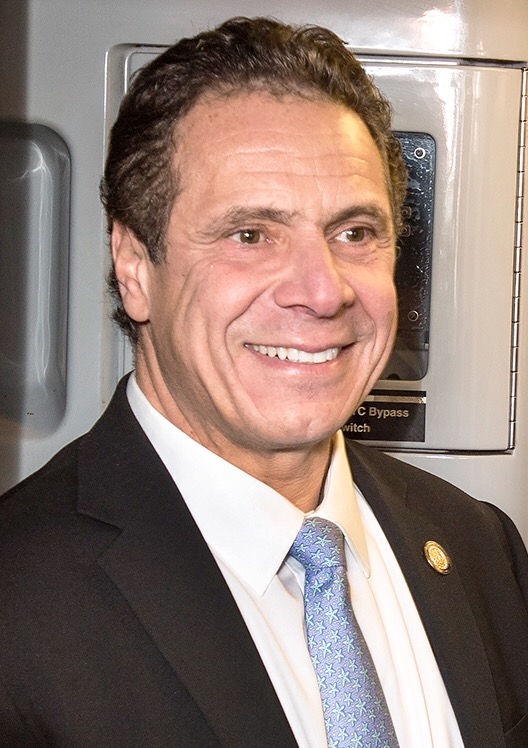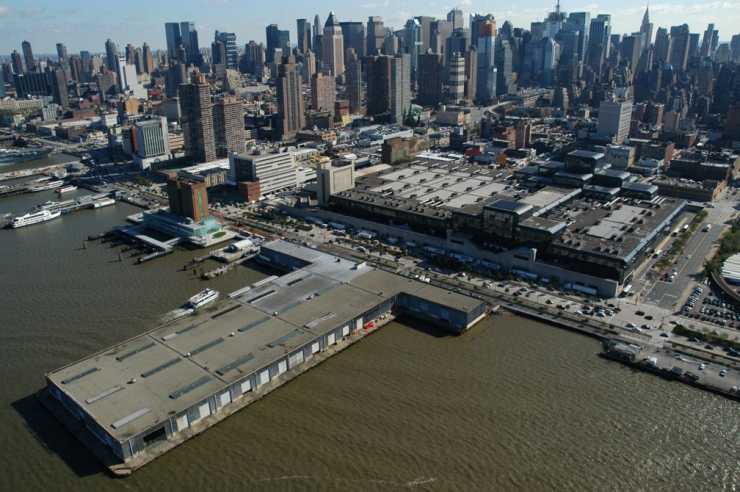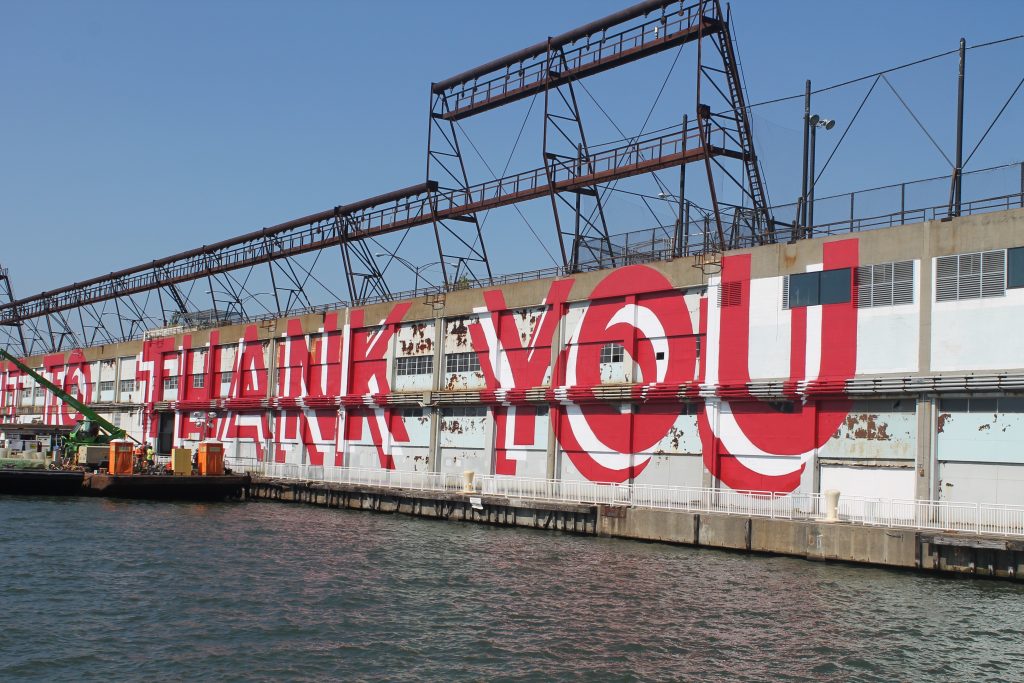BY LINCOLN ANDERSON | Updated, Sun., Jan. 5, 11:15 p.m. | Governor Cuomo is putting New York City and the Police Department on alert: You have one year to get the tow pound off of Pier 76 on the Hell’s Kitchen waterfront — and the clock is ticking.
In his strongest statement yet on Pier 76, Cuomo on Sunday announced that the “long-deferred” transfer of the 250,000-square-foot tow pound to the Hudson River Park Trust should happen by the end of this year.
If needed, the state will help the city find an alternative location for the tow pound, the statement said.
Five days earlier, in a stunning development, Cuomo vetoed a bill that would have allowed up to 800,000 square feet of office space to be developed at Pier 40, at W. Houston St.
The founding Hudson River Park Act of 1998 prohibits office use in the 4.5-mile-long park, so a legislative amendment (the bill) would have been needed to be approved by the state Legislature for it to be allowed at Pier 40.
In his letter explaining his veto, Cuomo pointed to Pier 76, at W. 36th St., saying it represents an untapped revenue source for the park, plus a lost opportunity for recreational space.

In his statement released Sunday, Cuomo said, “There is only a precious limited amount of green space left for community use, and we have to make sure we are protecting and preserving it on Pier 40 and Pier 76 and are carefully balancing the park’s financial needs with protection of green space. The redevelopment of this valuable land will maximize underutilized green space and recreational and market potential with the possibility of connecting regional landmarks like [the] Javits [Center] and the High Line.”
Under the Park Act, Pier 76 was slated to be transferred from the New York Police Department’s use more than 20 years ago — but it never happened.
The Park Act stated that New York City “shall use best efforts to relocate the tow pound on Pier 76.”
The W. 36th St. pier is “the last significant opportunity for West Side waterfront access,” according to the governor’s press release.
As part of Cuomo’s proposal, the Trust, in consultation with the de Blasio administration, local community boards, local politicians and other stakeholders, will develop a reuse plan for Pier 76.
Per the statement, this reuse plan should “maximize green space, recreation, community access and market potential” — with “market potential” meaning the pier’s revenue-generating ability.
Under the Park Act, half of Pier 76 is supposed to be redeveloped for park use and half for commercial use.
In addition, Cuomo’s press release calls for renewed comprehensive planning for Pier 40 and the whole park.
“The Hudson River Park must also develop an improvement plan for Pier 40,” the statement said. “In developing the plans for Pier 40 and Pier 76, the Hudson River Park Trust should develop a comprehensive parkwide financial and use strategy and if [the Trust] believes a plan would require any additional legislative authorization, they should present such requests by May 1 to be considered prior to the end of the legislative session.”
Traditionally, previous amendments to the Park Act have been pushed through quietly at the end of the Albany legislative session amid a flurry of voting on multiple bills and budget issues. Clearly, by setting an earlier deadline for notification, Cuomo wants to ensure there is adequate time to consider any proposed changes.
The Trust declined comment on the governor’s latest statement on Piers 76 and 40.

While some might see Cuomo’s intervention as wresting the park’s planning process away from the Trust, some think it’s more like Cuomo showing up his traditional sparring partner, Mayor de Blasio. The mayor, with the help of Council Speaker Corey Johnson, has been trying for a few years, but so far has been unable, to move the tow pound off Pier 76.
Cuomo’s announcement on Hudson River Park will be part of his State of the State address, to be delivered Wed., Jan. 8. In the run-up to the event, he has been “unveiling” the various proposals in his speech. This is Proposal No. 27.
State Senator Brad Hoylman cheered Cuomo’s message on Piers 76 and 40 and the park, in general.
“Hudson River Park serves as the backyard for the West Side of Manhattan, where public open space is in scarce supply,” Hoylman said. “It’s no wonder, then, that the park attracts more than 17 million visits each year. I’m extremely grateful to Governor Cuomo for using his State of the State address to announce legislative proposals to reaffirm his commitment to new open space at Pier 76 and Pier 40 and look forward to working with Community Boards 4 and 2, my colleagues in government, and other local stakeholders to help fully realize the potential of the Hudson River Park.”
Dan Miller, first vice chairperson of Community Board 2, also hailed the development. C.B. 2 covers the Village section of Hudson River Park, which includes Pier 40. Miller is also a member of the Hudson River Park Advisory Council.
“It’s exciting news,” Miller said. “C.B. 2 looks forward to working with the electeds, the Trust and community stakeholders as new park-centric plans are developed for Pier 40. You can count on C.B. 2 having an active role preserving what little open space we have and activating our community to create more park use in Hudson River Park.”
On Jan. 1, Lowell Kern was appointed the new chairperson of Community Board 4, which includes Chelsea and Hell’s Kitchen.
After Cuomo’s veto of the Pier 40 amendment on New Year’s Eve, Kern initially was concerned that the idea now was simply to shift the large office building planned at Pier 40 to Pier 76. But his updated understanding is that it’s a clean slate and a fresh start.
“I’ve been Community Board 4 chairperson for four days and the governor has already announced the tow pound is moving off of Pier 76, so I’m off to a good start,” he quipped to The Village Sun. “I am thrilled that the governor has taken another step forward to finish Hudson River Park.”
Kern said word is that the process Cuomo is encouraging for both the piers and the park, as a whole, will be a “holistic” one.
“I believe, with the governor’s help here, we are going to look at the park holistically,” he said. “We can find the best results for the Hudson River Park. It won’t be pitting the Village against Hell’s Kitchen.
“It’s not going to be an office building at Pier 40 that my friends in C.B. 2 hated, and I feel confident it won’t be an office building at Pier 76,” Kern said of his understanding of how the two key piers will be redeveloped. “I think the governor’s message is that Pier 76 is not going to be used to pay for Pier 40. We are going to view this all holistically and find the right solution for the entire West Side community — for the Village and Chelsea and Hell’s Kitchen.

“Quite frankly,” he added, “we all want the same thing — as much open space and ball fields as we can get.”
Kern, an attorney who lives in Chelsea, is a former board member of the Greenwich Village Little League.
“The greatest treasure of Pier 40 is the ball fields,” Kern declared, adding, “Pier 76 is large enough to support one ball field.
“The question is how do you pay for it?” he said of trying to keep Hudson River Park as parklike as possible while keeping commercial uses from overwhelming it. The park is supposed to be financially sustainable “to the extent practicable,” according to the Park Act, and Piers 40 and 76 are designated as “commercial nodes,” as well as park space.
While he’s optimistic at the governor’s statement and what he’s been hearing in conversations, Kern admitted that, “Something’s got to give somewhere. The Trust needs money to run the park. Where the money is going to come from and what commercial uses people will find acceptable, I don’t know yet. It’ll be an ongoing, collaborative process, including the community boards and local elected officials.”
Personally, he said, “a cafe looking at the river” would be the kind of low-impact, community-friendly amenity that would be good for the area — though maybe not a bigger moneymaker that the Trust would likely prefer.
Meanwhile, the board leader stressed, C.B. 4 desperately needs a park on Pier 76 because the stretch of the waterfront between 30th and 56th Sts. really is bereft of green space. That currently all asphalt-paved stretch features passenger-ship piers, the Intrepid Museum, the Circle Line and NY Waterway piers, a bike rental place and a lobster restaurant, but little in the way of grass and trees. Pier 57, at W. 15th St. — currently being renovated for Google offices (which were allowed by an amendment), a City Winery music venue and other commercial tenants — will have a park on top, while a park is also in the planning stage for the slab pier at Pier 97, at W. 57th St. But between those two points, greenery is scant.
“Pier 76 is really the only place you can have green space in that area,” Kern said.
Tom Fox, the former president of the Hudson River Park Conservancy, the Trust’s predecessor agency, and a longtime waterfront park activist, said Cuomo’s intervention at Piers 76 and 40 stands to right a wrong done the park during the tenure of former Mayor Mike Bloomberg.
“This is extremely encouraging,” Fox said. “One piece that would complete the picture would be to capture a portion of the inboard real estate value created by the park, as was initially intended. The original Friends of Hudson River Park proposed a NID in 2008 that could have accomplished this,” he said, referring to the idea of a Neighborhood Improvement District.
A NID, he said, “could help to minimize the scale of commercial development at both Piers 40 and 76 and insure the long-term maintenance and operation of the park.
“From 2005 to 2013, the Bloomberg administration rezoned the entire West Side and starved the Hudson River Park, as none of the new tax revenue was shared with the park that helped create it,” Fox said. “Then, Bloomberg invested $750 million in his legacy park projects — Governors Island, Brooklyn Bridge Park and the High Line. Meanwhile, Diana Taylor, who became the Hudson River Park Trust’s chairperson in 2007, was insisting that the park ‘must be self-sufficient.’
“The Hudson River Park was initially envisioned by Mayor Dinkins and Governor Mario Cuomo,” Fox said. “This is a great opportunity for Governor Andrew Cuomo to wrap it up and ensure the completion of his legacy.”
In addition, the Hell’s Kitchen Neighborhood Alliance recently sued to force the city and Police Department to get the tow pound off Pier 76. They are being represented by the firm of Alterman & Boop.
“I’m thrilled the governor’s taking an active part and really intends to actively involve the community in planning,” attorney Arlene Boop said. “I’m thrilled that he’s coming out for it as directly as he has. I’m thrilled that he wants to involve the stakeholders — these are the people who have been waiting 20 years for a park.”
But Boop reiterated they won’t withdraw the lawsuit until something final happens with the tow pound.
“Until either the tow pound is off or there’s a judge’s order telling them to be off,” she said.
In an e-mail to The Village Sun, Kathleen Treat, the alliance’s chairperson, thanked the governor effusively for his commitment — ending her remarks with the state’s Latin “ever upward” motto that Cuomo likes to use.
“H.K.N.A. (Hell’s Kitchen Neighborhood Association) applauds Governor Cuomo’s decision to back a public park in the space too long used by the N.Y.P.D. tow pound,” Treat said. “A public park is crucial for this rapidly growing population of young families.
“We thank our Gov and salute him! Excelsior!”

Terrific! Thank yous to the Gov and to Tom Fox, to Community Boards 2 and 4 and all the other activists who refused to give up on this over all these years since the Park was created. Although Boop is right—no celebration until the fat person sings; we must stay tuned.